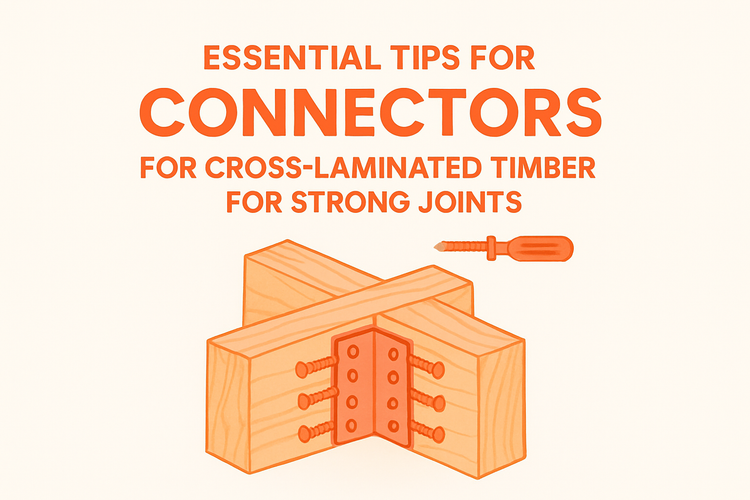Essential Tips For Connectors For Cross Laminated Timber For Strong Joints

Understanding Load Transfer in Cross Laminated Timber Connections
Effective joint performance in cross laminated timber (CLT) relies heavily on how forces transfer between connected panels. Load transfer is the core function of most timber connectors and directly determines joint strength.
In designing with CLT, axial, lateral, and shear forces must be accounted for, and the correct connector type should be chosen accordingly. Connectors like steel angles, screws, and high-load plates are specifically designed to cater to various load paths, minimizing deflection and structural failure. When working with Connectors for cross laminated timber, ensuring that the selected hardware matches both the direction and intensity of the applied forces can dramatically enhance joint reliability.
For instance, transferring vertical loads typically requires connectors with high bearing capacity such as joist hangers or concealed brackets, while lateral loads may benefit from the integration of restraint straps or angle brackets. Choosing connectors rated for these specific functions ensures the structure performs to its greatest potential with minimal degradation over time.
Choosing the Right Connector for Each Joint Type
Not all joints in CLT behave the same, and neither should the connectors used.
The geometry and load orientation of each joint influence its connector requirements. For example, end-to-end joints may benefit from mechanical fasteners that resist tensile and compressive forces, while corner joints require multi-directional resistance often best provided by stiff angles or plates. Timber frame connectors offer an excellent start point when selecting versatile joinery components.
Selection must also consider aesthetics, hidden versus exposed fittings, and fire ratings—especially important in public or commercial buildings. Hidden connectors provide a cleaner look for exposed timber architecture but may limit maintenance access, while exposed options allow for quicker installation and inspection. By combining both concealed and exposed connection strategies, you can balance visual appeal with engineering demands.
Many connectors integrate pre-drilled hole patterns, speeding up installation and reducing on-site errors. Selecting modular or adjustable hardware gives fabricators better alignment control, an essential aspect when working with prefabricated timber elements.
The Role of Screws, Nails and Fasteners in CLT Assembly
Fasteners like screws and nails form the foundation of CLT connection systems.
High-performance fasteners are designed for deep embedment into multiple timber layers, allowing each cross-laminated ply to contribute to a connector's holding strength. This is particularly vital for ensuring redundancy and resistance to progressive failure in large-scale timber construction.
Engineered screws, including self-tapping and full-threaded types, can offer substantial pull-out resistance and help pre-load joints for stiffness. Many-time-tested combinations of screws and angle brackets or steel side plates provide exceptional load distribution across panel surfaces.
Maintenance over time is generally minimal, though designers must consider potential wood shrinkage and fastener corrosion when planning long-term usage. Choosing fasteners with protective coatings or made from stainless steel ensures durability, particularly in outdoor or high-humidity environments.
Best Installation Practices for Durability and Precision
To ensure structural safety and performance, proper installation of connectors in CLT is vital.
Precision starts at the planning stage. Aligning bolt holes, ensuring uniform screw angles, and maintaining specified edge distances all contribute towards a low-risk, high-integrity joinery system. Even high-grade products, like those found in our CLT connector range, can perform poorly if installed without skilled labour or clear guidelines.
Pre-drilling is frequently recommended for minimizing timber splitting, especially close to panel edges. Pneumatic tools can expedite installation, but attention must be paid to torque settings to avoid damaging either the hardware or the timber layers. Clean cuts and burr-free hardware surfaces help maximize the seating contact, thereby reducing flex or slippage under load.
Moisture content in the timber should be within specification at the time of connection to avoid later shrinkage that may loosen fittings. Weather protection, such as wrapping or temporary sealing during construction, can be critical in preventing premature wood movement or degradation during prolonged build timelines.
Addressing Movement and Environmental Exposure in CLT Joints
Timber is a natural material that expands and contracts with humidity and temperature changes.
Connectors used in CLT must accommodate a degree of movement without compromising joint integrity. Flexible or slotted fastener systems help mitigate stress caused by wood shrinkage, rotation, and seasonal movement. For seismic and wind-load-prone applications, high wind ties & timber connectors provide essential anchorage and movement absorption capabilities.
Thermal bridging, particularly through metal fasteners, can also affect energy efficiency and condensation points, especially in tight-envelope designs. Use of thermal breaks or isolating components like nylon washers or spacers is advisable in critical joints that cross heated and unheated building zones.
In exterior applications, corrosion-resistant connectors should be specified. Changes in appearance or structural capacity over time can occur if galvanised or stainless-steel finishes are omitted in exposed joinery. Design considerations like drainage paths, ventilation, and cladding spacing play supporting roles in preserving connector lifespan and longer structural performance.
